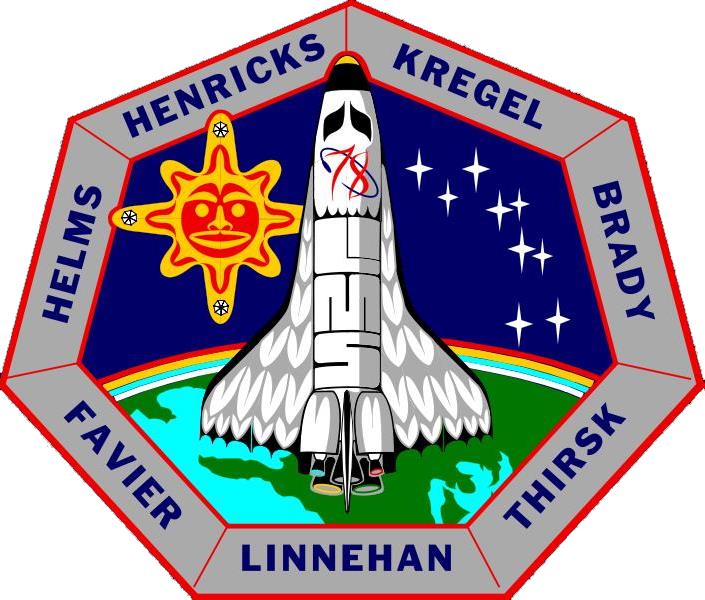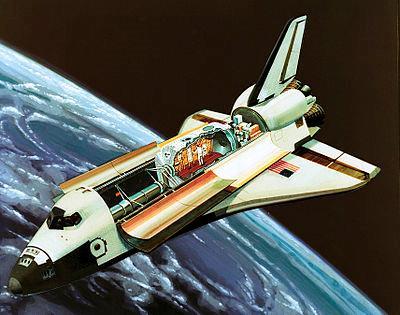Charles E. Brady Jr.
Spacelab 027 - STS-78
Mission Name: LMS
Astronauts:
Command Pilot:
Terence T. Hendricks
(Fourth Space Flight)
Pilot:
Kevin R. Kregel
(Second Space Flight) Mission Specialist 1:
Richard M. Linneham
(First Space Flight) Mission Specialist 2:
Susan J. Helms
(Third Space Flight)
Mission Specialist 3:
(Only Space Flight) Mission Specialist 4:
Jean-Jacques Favier,
CNES Mission Specialist 5:
(Only Space Flight) Payload Commander
Robert Brent Thirsk,
CSA (First Space Flight)
Spacelab was a reusable laboratory used on certain spaceflights flown by the Space Shuttle. The laboratory comprised multiple components, including a pressurized module, an unpressurized carrier and other related hardware housed in the Shuttle's cargo bay. The components were arranged in various configurations to meet the needs of each spaceflight.
Spacelab components flew on 22 Shuttle missions between November 1983 and April 1998. Spacelab allowed scientists to perform experiments in microgravity in Earth orbit.
Five space agencies (NASA/USA; European Space Agency/Europe; French Space Agency/France; Canadian Space Agency/Canada; and Italian Space Agency/Italy) and research scientists from 10 countries worked together on primary payload of STS-78, Life and Microgravity Spacelab (LMS). More than 40 experiments flown were grouped into two areas: life sciences, which included human physiology and space biology, and microgravity science, which included basic fluid physics investigations, advanced semiconductor and metal alloy materials processing, and medical research in protein crystal growth.
LMS investigations conducted via most extensive telescience to date. Investigators located at four remote European and four remote U.S. locations, similar to what will happen with International Space Station. Mission also made extensive use of video imaging to help crew members perform inflight maintenance procedures on experiment hardware.
Previous life science investigations have delved into what physiological changes take place in microgravity environment; integrated LMS experiments explored why these changes occur. Most extensive studies ever conducted on bone and muscle loss in space. STS-78 marked first time researchers collected muscle tissue biopsy samples both before and after flight. Crew members also were scheduled to undergo Magnetic Resonance Imaging (MRI) scans almost immediately after landing. Findings from comparison of the biopsy samples, along with various musculoskeletal tests conducted during mission, could lead to effective countermeasures to reduce inflight muscle atrophy.
Other life science investigations: First ever comprehensive study of sleep cycles, 24-hour circadian rhythms and task performance in microgravity. Spacecraft orbiting Earth pass through 16 sunrises and sunsets in single 24-hour period, which could disrupt normal body rhythms. During two 72-hour time blocks, crew members completed questionnaires and measured such functions as eye movement and muscle activity during sleep. In the Performance Assessment Work Station, crew members performed series of drills involving math problems and other mental tests to measure microgravity effects on cognitive, or thinking, skills.
Microgravity science investigations included Advanced Gradient Heating Facility, in which samples of pure aluminum containing zirconia particles were solidified. Could lead to more inexpensive ways to make mixtures of metals and ceramics, particularly useful to the metal casting industry. The Advanced Protein Crystallization Facility is first ever designed to use three methods for growing protein crystals. In Electrohydrodynamics of Liquid Bridges, which focused on changes that occur in a fluid bridge suspended between two electrodes. This research could finds applications in industrial processes where control of a liquid column or spray is used, including in ink-jet printing.
Crew performed in-flight fixes to problem hardware on the Bubble, Drop and Particle Unit (BDPU), designed to study fluid physics.
Orbiter itself played key part in test that could help raise Hubble Space Telescope to higher orbit in 1997 during second servicing mission. Columbia's vernier Reaction Control System jets were gently pulsed to boost orbiter's altitude without jarring payloads. Same exercise could be conducted with orbiter Discovery during Mission STS-82 to raise HST's orbit without impacting its solar arrays.
No significant in-flight problems experienced with orbiter.

Spacelab Space Missions
Study Research
Space Cosmology
Science Research
*
About
Science Research
Science Theories
Site Map
BookShelf
Desk
Copyright © by Nigel G Wilcox · All Rights reserved · E-Mail: ngwilcox100@gmail.com
Designed by Nigel G Wilcox
Powered By AM3L1A
Pages within this section: Spacelab 01-32
Spacelab C21-30
Sub-Menu
21
M
menu
22
23
24
25
26
27
8
29
30
28
>>>
D
SM









